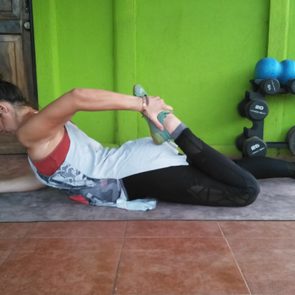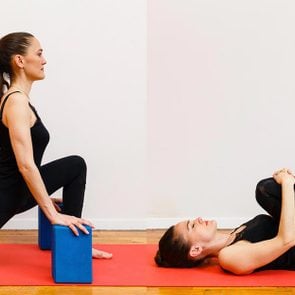5 Dynamic Stretches to Enhance Your Power and Strength
Updated: Jun. 10, 2021
Dynamic stretching is the perfect way to warm up before your next workout. Here's what it is, why you should try it, and the right moves to get you started.
Static vs. dynamic stretching
When you think of stretching, you probably recall gym class moves you did in elementary school—and you may still be doing them today. You know the drill: Bend down, touch your toes, and hold the position for a count of 10, 20, or 30.
This type of stretching protocol, known as static stretching, has been around for decades and has been pounded into the collective consciousness as one of the best ways to warm up and prevent injuries before a workout.
However, some people turn to dynamic stretching to both prevent injury and not compromise their power and strength performance during a workout. Some athletes even report diminished performance during their training when they do static stretching beforehand. So, what gives?
Here’s everything you need to know about static stretching—and why dynamic stretching may be a better alternative in the long run.
Stretching before physical activity
Research indicates that static stretching before a workout isn’t necessarily an all-around injury-prevention tool. And it may actually lower athletic performance, depending on the type of workout you’re preparing for.
For instance, a meta-analysis published in Research in Sports Medicine found that static stretching before a workout as part of a warmup does not reduce overall injury rates, although there’s some indication it might reduce injuries to muscles and tendons.
(Got tension and tightness? Try these IT band stretches.)
Moreover, in 2011 the American College of Sports Medicine released a position paper stating that, based on the evidence: “For most persons, a dynamic, cardiorespiratory endurance exercise warm-up is superior to flexibility exercise.” In other words, dynamic stretching beats static stretches when it comes to cardio and resistance exercise performance.
And in a review of stretching published in Current Sports Medicine Reports, researchers found that static stretching before a workout, particularly a workout focused on power or strength exercises, could ultimately reduce athletic performance. A better plan, the authors say, is to do dynamic stretching before a workout and static stretching after. (Learn more about when to do static vs. dynamic stretching.)
To stretch or not to stretch
Static stretching before a workout may reduce some (though not all) injuries, but it could also limit your performance. What’s a person to do: stretch or not stretch?
Part of the answer comes down to your goals and the types of workouts you’re performing. If you’re an elite CrossFit athlete who needs to maximize power and strength performance, static stretching before a competition isn’t worth the risk. On the other hand, if you’re a recreational athlete just looking to enjoy your next workout, a little static stretching is unlikely to do much harm and may help you avoid injuries.
As the studies above suggest, the key to a better workout may be in the type of stretching you do before exercise. Enter: dynamic stretching.
What is dynamic stretching?
Dynamic stretching is a controlled, active form of stretching that limits or avoids holding a stretched position for an extended period of time. When doing a static stretch, you move to the end of your comfortable range of motion at a muscle and joint, then hold the position without moving.
But when doing dynamic stretches, the goal is to take your actively working muscles through a continuous and full range of motion for repetitions. Here, you’re touching the comfortable limits of your flexibility at a particular joint without pushing through them or using force or velocity to maximize your position.
The goal is to target the muscle groups you’ll use during your workout, preparing them to be worked by creating a brain-body connection as part of your warm-up protocol.
Walking lunges or air squats
If you’re planning on doing a leg workout, a dynamic stretching routine might include a series of walking lunges or air squats. As part of your dynamic stretching series, you’d move through a full range of motion, focusing on form, hitting the limits of your personal range of motion without trying to push past them, repeating the exercise roughly 10 to 12 times. (Here are some leg stretches you can do before and after your workout.)
Sun salutations
Another great example of dynamic stretching is a sun salutation series in yoga. While you may end up holding the pose for a count of three to five breaths, the hold is really a “pause” before continuing on through a fluid series of poses, each of which you perform multiple times. (Here’s how to do sun salutations at home.)
A “pause” in dynamic stretching
Short pauses during a dynamic stretching routine, considered “short-duration static stretching,” appear to be supported by research as an effective way to assist in an athletic warm-up for the general population.
A 2019 meta-analysis published in Frontiers in Physiology points to this combination of dynamic stretching and short-duration static stretching as improving flexibility while preparing muscles for greater work. This comes without the side effect of significant performance deficits.
The catch, of course, is that power and strength athletes should still avoid these short-term static holds before a competition or performance due to the potential negative side effects on performance.
(Improve your mobility with these stretches for hip pain.)
Dynamic stretching the right way
On a whole, dynamic stretching is a safe and effective form of pre-athletic movement that almost everyone should feel comfortable trying. Because you’re only moving to the end of your personal range of motion, there’s little risk for injury or pain.
Practically speaking, what does it mean to touch the limits of your flexibility without pushing past it? You’re not trying to “overstretch” any given joint; you’re simply moving to the point where you feel a stretch, then backing away again.
The important thing to remember is that dynamic stretching is controlled. You’re not using momentum, velocity, or force to push past any normal range of motion. And because dynamic stretching is generally used as part of a warm-up routine, “slow and steady” should be your focus.
(Try this 10-minute full-body stretching routine.)
Dynamic stretching vs. ballistic stretching
One thing to remember is that dynamic stretching is not the same as ballistic stretching. If you think back to elementary school, you may have performed the “butterfly stretch” where you sit with your knees bent, the soles of your feet together, your knees opened outward toward the floor. Your instructor may have told you to “flap the wings,” or bounce your legs up and down, during this stretch. This is an example of ballistic stretching, where momentum, velocity, and force are used to hit the ends of your natural range of motion.
For most people, ballistic stretching, particularly before a workout, could be a recipe for stretching-related pain or injuries. Some people confuse ballistic stretching and dynamic stretching, or turn dynamic stretches into ballistic stretches by adding momentum to the movements. Avoid the temptation.
Let’s say you’re performing a leg swing, which involves swinging your leg outward as high as it will go before swinging it down and across your midline. If you add speed and force or use momentum to perform the swing, it becomes more ballistic rather than dynamic.
When performing dynamic stretching, it’s important to focus on controlled, slow, and steady movements.
(Workout early? Try these morning stretches for energy.)
Dynamic stretching routine
Try this series of dynamic stretches before your next workout, adapted from personal trainer Jared Rodriguez of Body Inspired Fitness in Santa Monica, California.
(Also, try these warm-up exercises before your next workout.)
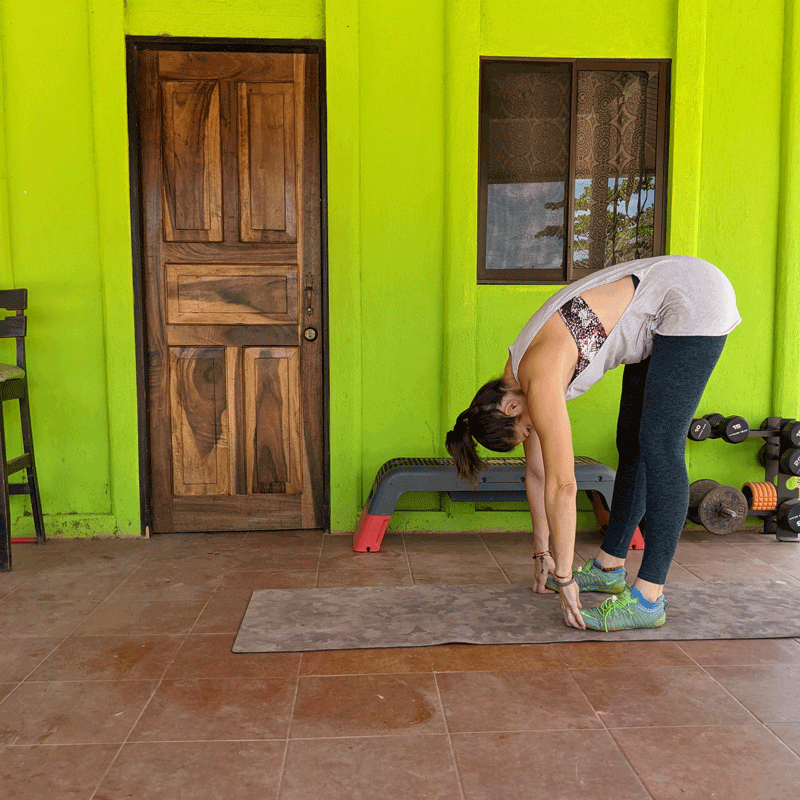
Toe touch to squat
To warm up and stretch out all of the major muscle groups of your lower body, including your hamstrings, quads, glutes, and even your low back, you’ll start with the toe touch to squat.
With your feet hip-distance apart, your knees slightly bent with your chest up, abs engaged, and torso tall, tip forward from the hips and lean down to touch your toes. You can bend your knees as much as you need to to make this movement comfortable. Lightly grab the front of your shoes, or hook your hands under your toes with your arms between your legs and your elbows touching the inside of your legs.
From this forward-bent position, which should lightly stretch your hamstrings, move steadily into a squat to start stretching your quads and glutes.
Keeping your hands in place, bend your knees and lower your glutes down toward the floor as you simultaneously lift your chest and look forward. The goal is to lower your hips as close to the floor as you can for a deep squat, while still respecting your own range of motion limitations.
You can hold the bottom position for a second or two, then reverse the movement, extending your knees and lowering your chest back to the forward fold position. Repeat for a total of 10 to 15 repetitions.
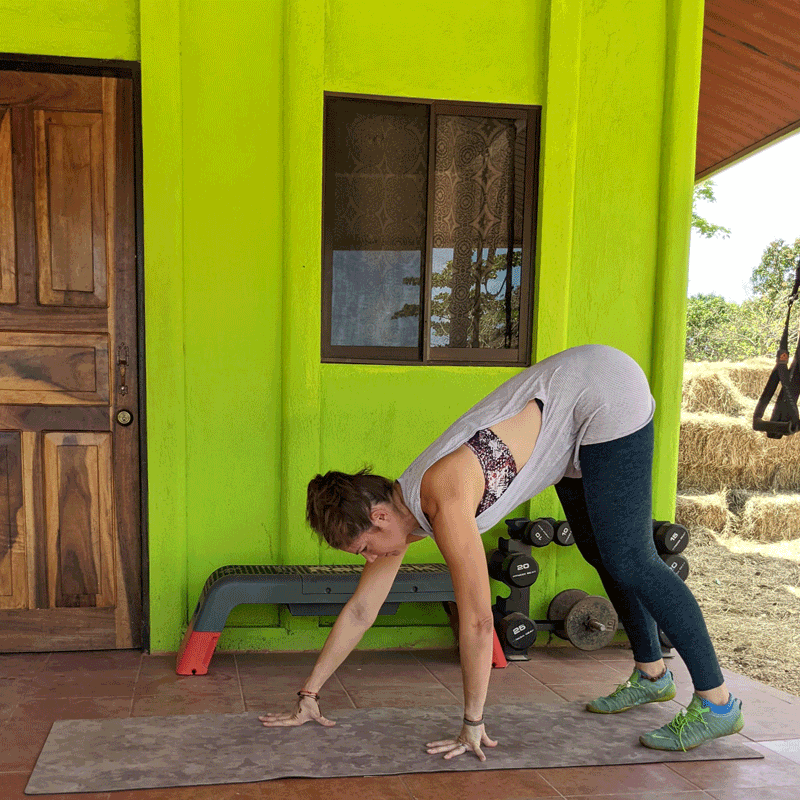
Inchworm
You can move directly into the inchworm position from the toe touch to squat. This exercise will further target your hamstrings, while also engaging your core, shoulders, triceps, and chest.
From the forward-bent position, with your feet hip-distance apart, your knees bent so as not to overstretch your hamstrings, your chest and arms hanging between your legs, place your hands on the floor so they’re directly under your shoulders.
Engage your core and walk your hands forward, right hand then left, until your body is in a full plank or pushup position. Your body should form a straight line from heels to head. Your hands should be directly under your shoulders.
Tighten your glutes (butt) and tuck your pelvis under to make sure your torso and hips are fully extended. Hold for a breath or two, then reverse the movement, walking your hands back to the forward-fold position.
Roll your body up, vertebrae by vertebrae, until you’re in a standing position. Repeat for a total of 10 to 15 repetitions.
(Here are some more ways to stretch your triceps.)
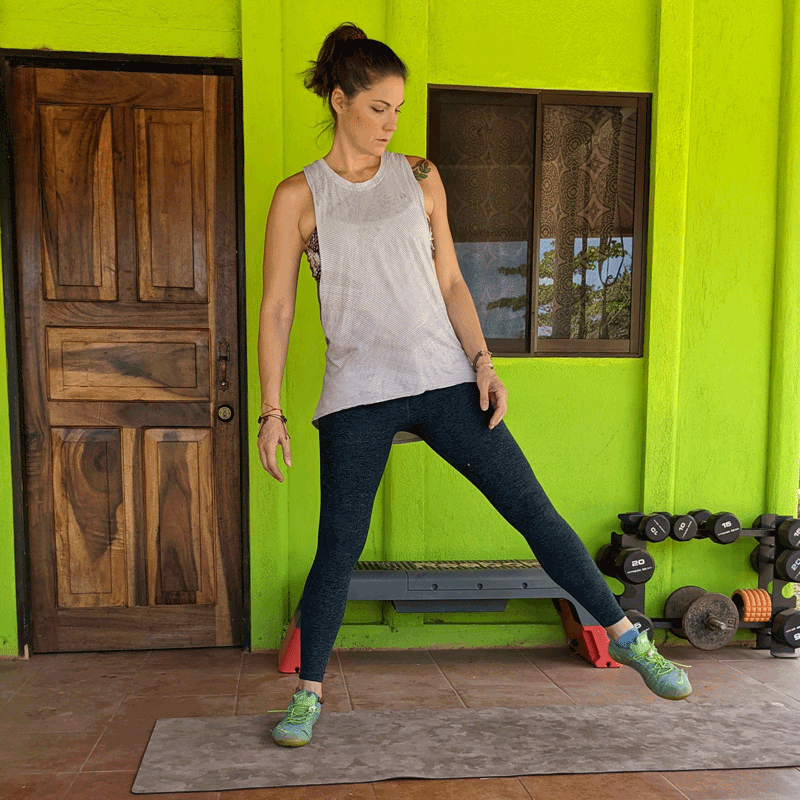
Dynamic lateral lunge
The dynamic lateral lunge will target the major muscles of your lower body, including your glutes, hamstrings, hip flexors, and quads, while further warming up your core. What makes this different from some other lower-body dynamic stretches is that it focuses on your abductors and adductors (the muscles that move your legs into and away from the midline of your body), preparing you for lateral exercises during your workout.
Stand tall with your feet roughly hip-distance apart, your knees slightly bent. Your core should be engaged, your shoulders back, with your chest lifted. Take a step to the side with your left foot. Press your hips back and bend your left knee, keeping your right leg straight as you lower your hips closer to the ground in a lateral lunge.
When you reach the end of your comfortable range of motion, straighten your left knee, rising to stand with your chest tall (while keeping your feet fixed).
Bend your right knee and press your hips back again as you move the lunge to the right side, keeping your left leg straight. When you reach the limit of your flexibility, straighten your right leg and rise to a stand. Move your right foot next to your left and stand up tall.
From here, return your left foot to the hip-distance position and repeat the lateral lunge, this time leading with your right foot. Continue the stretch (lunge, lunge, feet together) for a total of 10 repetitions per side.
(Try these quick 60-second workout moves.)
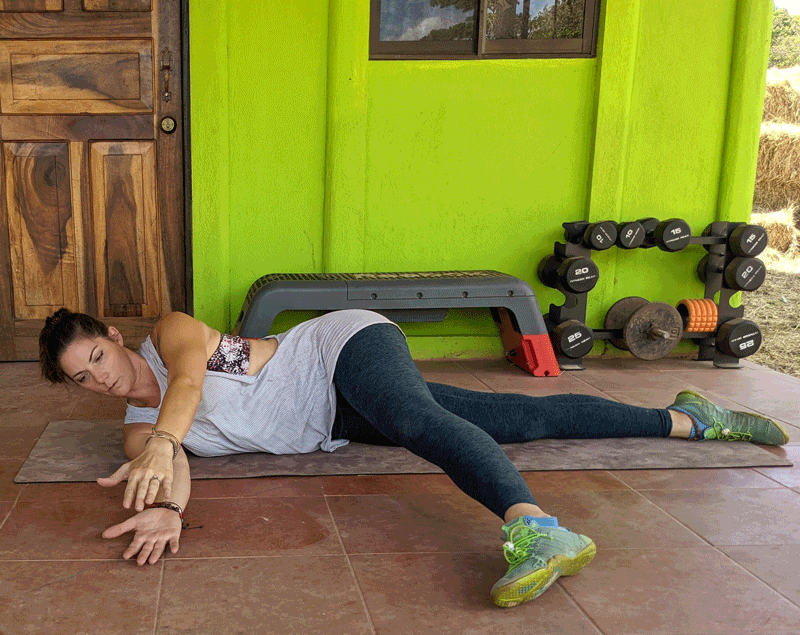
Side-lying book openers
To target the major muscle groups of your upper body, including your chest, shoulders, and upper back, you’ll want to try side-lying book openers. Lie on your left side on a mat, your arms extended directly in front of your chest, your right arm stacked on top of your left. For support, extend your right foot forward, placing your foot on the ground in front of you wherever it feels most comfortable.
It’s fine if there’s a slight bend in your knee. Your left leg should be extended directly down from your hip.
From this position, keeping your hips and lower body steady, reach your right arm directly up and over your body, in a wide arc, extending it behind you as if to touch the floor behind you. You can allow your right leg to move as needed to maintain balance. But keep the position of your lower body and hips steady; rotation comes from your core, spine, and shoulders.
When you’ve reached as far back as you comfortably can, reverse the movement and “close the book” to return to the starting position.
Repeat 10 to 12 times on one side before switching sides.
(These are the best thigh exercises to tone your legs.)
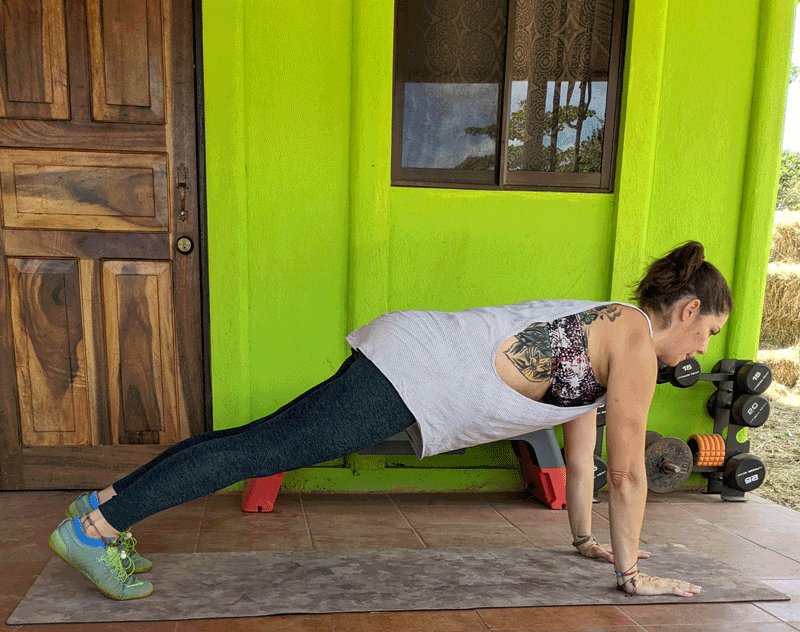
Lunge with torso twist
These moves stretch your entire body, including your core, shoulders, chest, back, hip flexors, hamstrings, and even your calves.
Start in a push-up or plank position, with palms directly under your shoulders, core engaged, and body fully extended to form a straight line from heels to head.
Take a large step forward, placing your left foot on the ground outside of your left hand. From here, lift your right hand from the floor, using your left foot, left hand, and right foot to continue to support the plank position. Reach your right hand upward, twisting your torso to the right until your hand extends toward the sky.
Hold for a second before reversing the movement and returning your right hand back to the floor. Step your left foot back to plank position and repeat on the opposite side.
Perform a total of 10 lunge and twists per side.
Next, feeling stressed? Try these stretching exercises for stress relief.



















